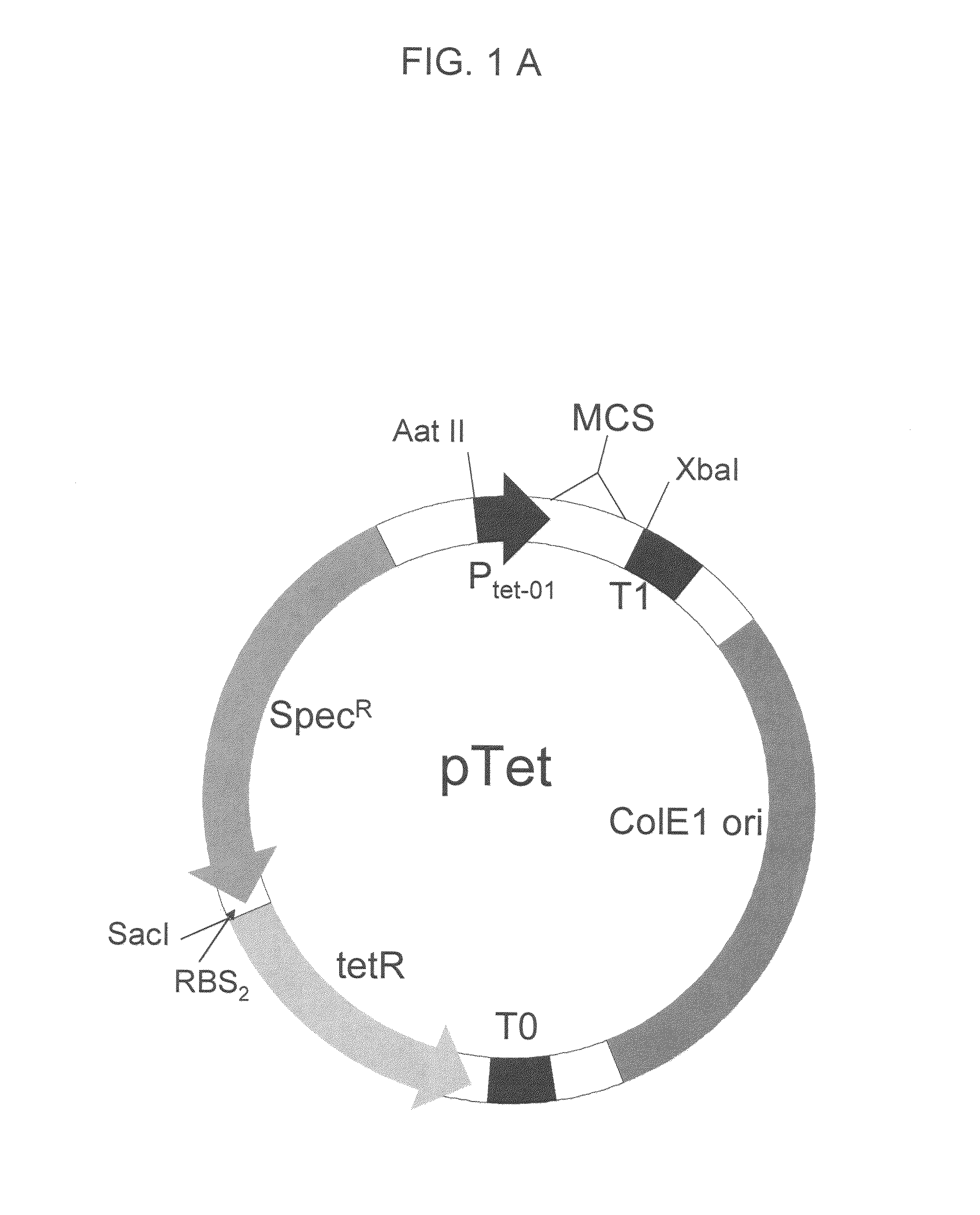Nucleic acid encoding a self-assembling split-fluorescent protein system
a protein system and protein technology, applied in the field of nucleic acid encoding a self-assembling split-fluorescent protein system, to achieve the effect of monitoring protein expression and solubility
- Summary
- Abstract
- Description
- Claims
- Application Information
AI Technical Summary
Benefits of technology
Problems solved by technology
Method used
Image
Examples
example 1
Constructing plasmid pTET-SpecR
[0158]The commercial tet-promoter PRO Bacterial expression system (Clontech, Palo Alto, Calif.) has the regulatory protein tetR on a second plasmid separate from the expression plasmid, making the creation of large libraries inefficient. To overcome this limitation, we combined the tet promoter which controls the expression of target proteins, and regulatory protein tetR, on a single plasmid containing the tetracycline-inducible promoter tet, the tet promoter regulatory protein tetR, and the selectable antibiotic marker SpecR, which confers resistance to the antibiotic spectinomycin. The ColE1 origin of replication allows this plasmid to co-exist in cells carrying plasmids with a compatible origin such as the p15 origin. This allows one protein, such as a protein tagged with a fragment of GFP, to be expressed from the pTET plasmid, and another protein, such as the complementary GFP assay fragment, to be expressed from a second plasmid, such as a pET ve...
example 2
Finding Feasible Pairs of Split GFP
[0172]To achieve the split GFP protein tagging and detection scheme outlined in FIG. 2, we first tested several pairs of fragments from either folding reporter GFP, which bears the mutations F99S, M153T, V163A (Crameri, Whitehorn et al. 1996), F64L, and S65T (Patterson, Knobel et al. 1997), or the exceptionally stable “superfolder” GFP, containing the folding reporter GFP mutations and S30R, Y39N, N105T, Y145F, I171V, and A206V. We separately co-expressed several pairs of GFP fragments on compatible plasmids in E. coli, including amino acids 1-145+145-238, 1-155+156-238, 1-171+171-238, 1-195+196-238, 1-214+214-238. The junction points corresponded to loops or turns between β-strands (Tsien 1998; Baird, Zacharias et al. 1999) (see FIG. 3). Fragment pairs from superfolder GFP consistently gave much brighter colonies than the same pairs from folding reporter GFP. For example, superfolder GFP fragments from split at 156 and 172 were brighter than fragm...
example 3
Engineering the GFP Assay Fragment GFP 1-10
[0175]We evolved superfolder GFP 1-10 by DNA shuffling (Stemmer 1994) to improve its solubility and increase its complementation with sulfite reductase-GFP 11. Superfolder GFP 1-10 PCR amplicons were subjected to DNA fragmentation and shuffling using published protocols (Stemmer 1994). The GFP 1-10 cDNA library plasmid was transformed into an E. coli BL21 (DE3) PRO expression strain (Clontech, Palo Alto, Calif.) containing the sulfite reductase-GFP S11 wild type tagged protein on a pPROTET vector (Clontech, Palo Alto, Calif.). The expression library was plated on nitrocellulose membrane using two successive 400-fold dilutions of a 1.0 OD600 nm frozen 20% glycerol / Luria-Bertani (LB) stock. After overnight growth at 37° C., the membrane was transferred to an LB / Agar plate containing 50 μg kanamycin, 35 μg chloramphenicol, and 50 μg spectinomycin per ml of media, plus 1 mM IPTG for 3 h at 37° C., and then moved onto a new plate containing the ...
PUM
| Property | Measurement | Unit |
|---|---|---|
| temperature | aaaaa | aaaaa |
| temperature | aaaaa | aaaaa |
| volume | aaaaa | aaaaa |
Abstract
Description
Claims
Application Information
 Login to View More
Login to View More - R&D
- Intellectual Property
- Life Sciences
- Materials
- Tech Scout
- Unparalleled Data Quality
- Higher Quality Content
- 60% Fewer Hallucinations
Browse by: Latest US Patents, China's latest patents, Technical Efficacy Thesaurus, Application Domain, Technology Topic, Popular Technical Reports.
© 2025 PatSnap. All rights reserved.Legal|Privacy policy|Modern Slavery Act Transparency Statement|Sitemap|About US| Contact US: help@patsnap.com



